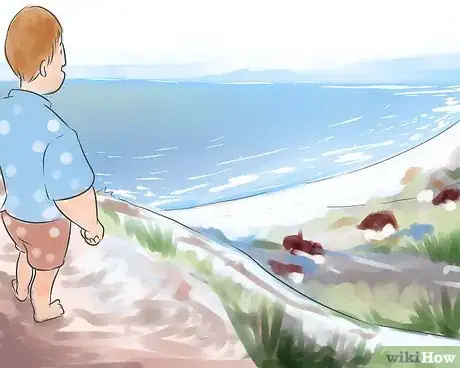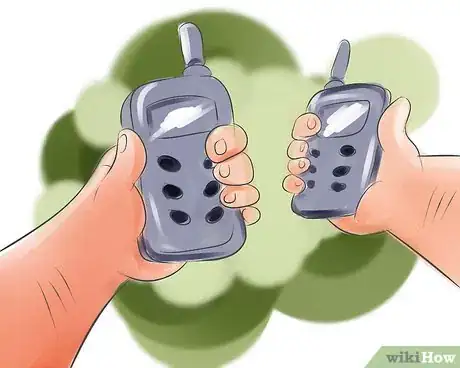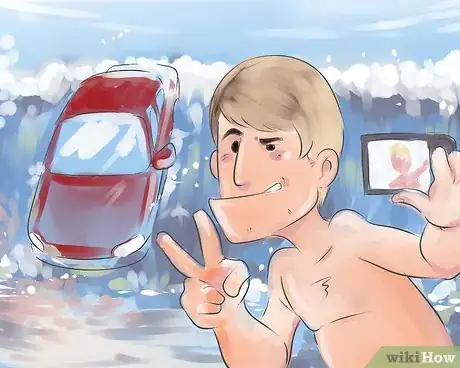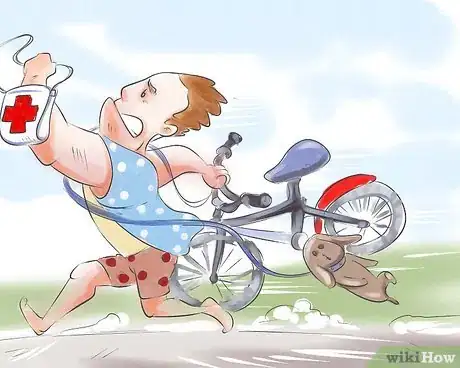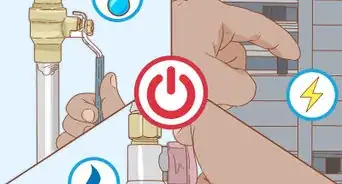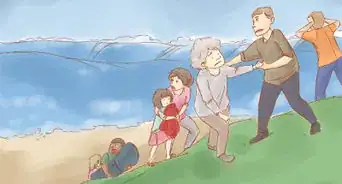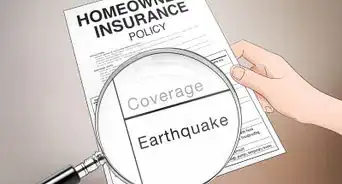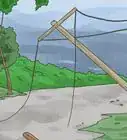wikiHow is a “wiki,” similar to Wikipedia, which means that many of our articles are co-written by multiple authors. To create this article, 97 people, some anonymous, worked to edit and improve it over time.
There are 13 references cited in this article, which can be found at the bottom of the page.
This article has been viewed 237,694 times.
Learn more...
Tsunamis are a series of waves caused by a massive disturbance of water. In general, tsunamis are not particularly threatening, as they constantly happen every day around the world, often in the middle of the ocean. In fact, most tsunamis don't reach much higher than regular ocean waves on the beach. But in some cases, the tsunami will develop into potentially destructive waves. If you live in a coastal area, it's imperative that you know what to do should this situation arise.
Steps
Being Prepared in Advance
-
1Know your community's evacuation routes. If you live in a coastal community, you probably have an evacuation route, even if you're not aware of it or if it's not often talked about. In short, it'll be the quickest way to reach high ground. You want to be, ideally, 2 miles (3.2 km) away from shore and at least 100 feet (30.5 m) above sea level.[1]
- If you are a tourist, ask your hotel or various approachable locals about policy, if you're concerned. Familiarize yourself with the terrain so if the worst were to happen, you could fend for yourself. Even though you'll probably be following everyone else, know that they're heading for high ground, too, and you should do the same.
- And those evacuation routes won't really do you much good if you don't practice them. So round up the kids and the family dog and...GO. How long does it take to reach your safety spot? Are there any potential issues that could crop up? Do you know how to reach your back-up route in the event one is impassable or jammed?[2]
-
2Make an emergency kit for your home, work, and vehicle. You want one available for wherever you may be when the time comes. Worst-case scenario is you get caught somewhere for a few days before evacuations start happening, so you want 72 hours worth of goods.[3] Put in things like a roll of toilet paper, first aid equipment, energy bars, and water. Here's a list to get you started:
- Water (A large amount to last for about a week)
- A prepaid sim card in a phone (Be sure the phone has a long lasting battery)
- Canned or packaged foods (A large amount to last for about a week)
- Flashlight (hand cranked flashlights are a good idea)
- Radio (tuned to NOAA station that gives the "all clear" signal)
- Sanitary items such as toilet paper, moist towelettes, garbage bags, zip ties, hand sanitizer.
- First aid equipment (band-aids, gauze pads, etc.)
- Whistle
- Map
- Tools (wrench to turn off utilities, manual can opener)
- Duct tape
- Spare clothes
- Anything for individuals with specific needs (infants, elderly, etc.)
Advertisement -
3Have a family communication plan. If you're at work, the kids are at school, and your spouse is at home, all the group planning in the world won't do you any good. Have a plan on where to meet if a tsunami were to strike when you're in different areas. Invest in a set of walkie talkies and outline the plan, making sure all parties understand that that's where they need to meet, regardless of circumstance.
- If you have kids that are in school, familiarize yourself with their policy. They may take the kids to their own spot. Ask your student's teacher or a faculty member about their tsunami policy.
-
4Take a first aid course. If your community gets hit, people like you may need to rise to the occasion. If you have taken a first aid course, you can administer CPR, attend to basic injuries, and help save lives. Including your own or that of someone you love.
- Definitely read up on wikiHow's first aid and emergency articles, but consider taking a legit course from a nearby school, hospital or community center. You'll be helping better the world from day 1.
-
5Learn some survival skills. If you know what do when in 4 feet (1.2 m) of water and a Toyota Corolla is coming at you, you can stay calm and, most importantly, survive. And then there's the skills that help you survive when the community is in shambles. Were you a girl or a boy scout, by any chance?
- Once you know how to predict a tsunami and how to handle the situation when it comes, your main duty is to pass your learning onto others. If your community doesn't have a program, start one. It's imperative that everyone knows how to operate under these conditions.
-
6Look into flood insurance. "Tsunami insurance" just isn't really a thing, but flood insurance definitely is. If your house is even a half mile to a mile away from the coast, inquire about it.[4] The last thing you want to worry about is reconstructing your life when you have so much else on your plate. Having insurance at least eliminates some financial stress.
- Invest in a hurricane shelter if possible. The more mental anguish you can avoid, the better—and having a hurricane shelter can be a serious load off. Your emergency route would lead you there and you could stash your emergency kits in it as well. Home away from home, if need be.
Recognizing the Signs
-
1Know that an earthquake often precedes a tsunami. Though not 100% of the time, usually a coastal earthquake is what sets off a tsunami.[5] So if at any point the ground beneath you is even quivering, go on high alert. A tsunami could come in a matter of minutes or matter of hours. Or it could not come at all.
- Tsunamis also have a tendency to travel.[6] An earthquake can happen in Alaska and a tsunami can strike in Hawaii. This is all quite scary, so just take note that they don't happen incredibly often—most waves lose energy out at sea, far away from civilization.
-
2Look to the sea. Usually during a tsunami, the water will recede very far back. The water will be inactive, and the only waves will be very small and barely make it up to the beach. Nearby boats and ships will be likely to bob up and down. A small wave might come up and fill the water where it is supposed to be, but then it will recede back in a second. These are excellent signs that a tsunami is coming.[7]
- Do a quick YouTube search right now for videos—it's quite startling. If you think you won't be sure whether or not the tide has receded, think again. So much land that almost never breathes air will make its fateful appearance and it'll be impossible to ignore.
-
3Understand that if you are sure that something is going to happen, you should warn other people immediately. Get everyone to evacuate the beach and any area near the shore. Yell, scream, and make an idiot out of yourself if you need to in order to grab their attention. Many people will be entranced by the odd behavior of the ocean and not realize something is wrong.
- If you don't want to jump to conclusions, look to the animals. How are they acting? We may be technically smarter than them, but they know when nature has gone awry. If they're acting funny, something is definitely up.[8]
-
4Know that a tsunami can be more than one wave. And they can be separated by short or very long periods of time. So if the first wave is not very aggressive or not very big, don't think you can go back to the beach and that your tsunami did not live up to the hype. Many times people think that the tsunami is over and are injured or killed by the second or third wave.[9]
- Tsunamis spread, so a small wave in one area could be a behemoth of a wave in another. If you hear word that another area has been hit, presume yours will be too, though the gravity of the wave could be very different.[10]
Taking Action
-
1If you're a native, follow your evacuation plan. Depending on the tsunami, sometimes one mile isn't enough. The wave can sweep as much as 2,000 feet (609.6 m). It doesn't happen often, but you want to be as safe as possible and assume the worst. So get far away from the water and get to high ground.
- Ideally, you want high ground that's natural, like a mountain or hill. The 32nd floor of a high-rise that gets swept away and turned to rubble by the current is not a good place to be.[11]
-
2If you're a tourist, just go. The last thing you expected on your week-long, relaxing visit to Thailand was a tsunami, but that doesn't mean it won't happen. You could be casually resting on the beach, eyes closed, earbuds in, and all of a sudden the tide starts acting as if it has a mind of its own. When that happens, head for the hills.
- Even if it's on foot, just run. Follow the locals. Tourists are often the ones absent-mindedly looking to the sea and then not running till it's too late; you see the locals scatter way before the visitors.
-
3If you're in the sea, go further out to sea. Take your boat and go far from shore (but you should know how to get back from there). You'll waste far too much time getting to shore and docking. Apart from that, in the middle of nowhere, the waves have room to spread out and thus their ferocity gets exponentially diminished. That and you don't run the risk of the side of a building or a semi-truck hitting you in the face; you'll be much safer at sea. Half the danger of a tsunami lies in the debris, just like in a tornado.[12]
-
4Grab your kit (if it's nearby) and seek high ground. That's why you have a kit everywhere you could possibly be. So whether you're high-tailing on foot, on a bicycle, or in your car, grab it and go. Once you're there, use your radio to tune in to your weather alert station and use the walkie-talkie to channel your family. Is everyone on their way?
- Oh, and grab your pet, too. Don't make the little guy fend for himself! Is there food you can spare for him in the kit if need be?
-
5Understand that if you are caught in the tsunami's grip, don't fight the current. You might drown. A bunch of deadly debris might be floating by, such as cars, trees, or rocks. Try to grab onto the debris or something solid in the ground, like a pole. If you can't grab the debris, try to avoid it. Move out of its way swiftly or duck beneath. If you grab something or float on something until the water subsides or you are able to get away from the wave, you are likely to survive.[13]
- In short, if you can't beat 'em, join 'em. And a tsunami is one move Mother Nature has up her sleeve that you definitely can't beat. So if you do get swept up in her power, roll with it. Grab the nearest SUV that's going for a new-age joy ride and hang on. The worst will be over in the first few seconds.
Community Q&A
-
QuestionWhat shouldn't I do when preparing for a tsunami?
 Community AnswerDon't stay in a low place. In fact, you should get to the highest point nearby.
Community AnswerDon't stay in a low place. In fact, you should get to the highest point nearby. -
QuestionWhat do I do if I'm caught in a tsunami?
 Community AnswerIf you get swept away into the tsunami, hold onto something and don't try to fight the current.
Community AnswerIf you get swept away into the tsunami, hold onto something and don't try to fight the current. -
QuestionWhat if I am on a boat out at sea, and there is a tsunami?
 Community AnswerGo as far as you can toward the middle of the ocean. It may seem counter productive, but the tsunami will be a lot weaker and you have a better chance of surviving. If possible when the tsunami is small, try to go over it before the wave curls over, but after that don't think it's over, another wave could hit in minutes or hours. Stay put in the middle of the ocean as it's your best bet. Take shelter in your boat.
Community AnswerGo as far as you can toward the middle of the ocean. It may seem counter productive, but the tsunami will be a lot weaker and you have a better chance of surviving. If possible when the tsunami is small, try to go over it before the wave curls over, but after that don't think it's over, another wave could hit in minutes or hours. Stay put in the middle of the ocean as it's your best bet. Take shelter in your boat.
Warnings
- Don't fight the speed of the current. The current is much stronger than you. If you fight it, you risk drowning or being sucked down by the surge of water.⧼thumbs_response⧽
References
- ↑ https://www.popsci.com/what-to-do-tsunami-survival
- ↑ https://www.wunderground.com/prepare/tsunami
- ↑ https://www.ready.gov/kit
- ↑ https://www.iii.org/fact-statistic/facts-statistics-flood-insurance#Coastal%20Flood%20Insurance
- ↑ https://www.livescience.com/8824-earthquakes-tsunamis.html
- ↑ https://www.nationalgeographic.com/news/2005/1/tsunamis-facts-about-killer-waves/
- ↑ https://www.nationalgeographic.com/news/2005/1/tsunamis-facts-about-killer-waves/
- ↑ https://www.livescience.com/40628-animals-predict-earthquakes-oarfish.html
- ↑ https://www.livescience.com/37497-no-outrunning-tsunami.html
- ↑ https://www.britannica.com/event/Japan-earthquake-and-tsunami-of-2011
- ↑ https://www.slate.com/news-and-politics/2011/03/japan-tsunami-how-to-survive-a-tsunami.html
- ↑ https://www.ready.gov/tsunamis
- ↑ https://www.nytimes.com/2019/05/07/magazine/how-to-survive-a-tsunami.html
- ↑ https://www.civildefence.govt.nz/assets/Uploads/publications/ts-01-08-national-tsunami-signage.pdf
About This Article
To prepare for a tsunami, start by familiarizing yourself with the area and finding a route that will get you and your family to the highest ground in the least amount of time. Then, prepare emergency kits to keep in your home, workplace, and vehicle. Your emergency kit should include enough bottled water and canned food to last 1 week, a flashlight and batteries, and tools like wrenches and hammers. Additionally, keep a first aid kit in your emergency bundle, and stock it with items like bandages, pain reliever, and sanitary items like toilet paper. To learn how to recognize the signs of an impending tsunami, keep reading!
